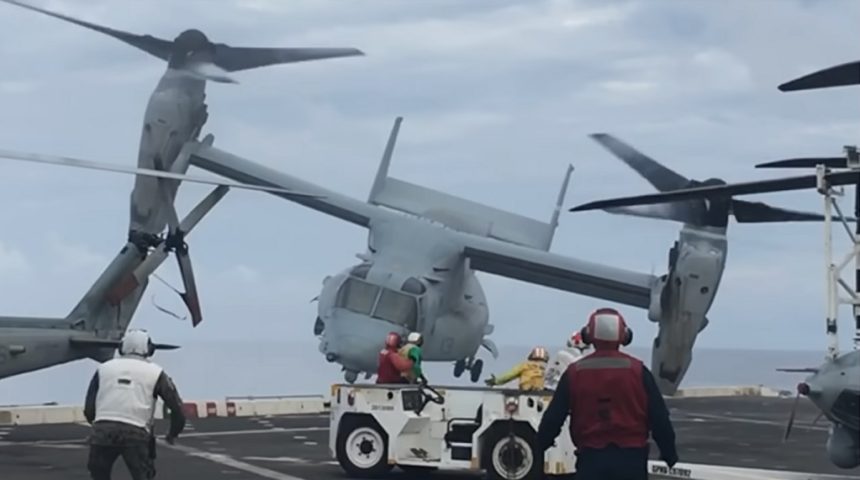The video was captured by personnel on the flight deck, but seemingly never released before.
On August 5, 2017, a U.S. Marine Corps MV-22 Osprey crashed off the coast of Australia while on final approach to amphibious transport dock USS Green Bay (LPD-20). Three Marines lost their lives in the crash, while 23 were rescued with minor injuries. Now, on July 2, 2022, a terrifying video from the crash was posted online by the YouTube channel What You Haven’t Seen, showing what happened that day on the flight deck. It appears that the video was never published before and was recorded from the Green Bay’s hangar door.
The video shows the tiltrotor during the final approach as it is being marshalled to its landing spot by the aircraft director. As the Osprey is turning around its yaw axis to get in the correct position for the touchdown, it seemingly lost lift in the left side, striking the flight deck with the left engine nacelle while the cockpit section struck the starboard side of the USS Green Bay, before falling in the sea.
A year later, the USMC released the investigation report, where it was determined the aircraft crashed due to facing too much downwash and not having the thrust to hold its hover, but also the aircraft may have been carrying too much weight. The investigation outlined a complex but low-risk mission for the Osprey, but also made clear that no one was at fault in the incident and that all three personnel died in the line of duty and not due to misconduct.
“The mission was complex, challenging, and included flying into and out of a highly congested operational area. Executing this mission required a detailed plan and superior technical performance. The Marines manning the mishap aircraft were mission capable, fully-trained, and qualified. The mishap aircraft was mechanically sound,” said the report.
USNI News published the report of the investigation when it was released, here is an excerpt describing what happened:
As the Osprey approached Green Bay, it initially had trouble connecting to the ship’s Tactical Air Navigation signal and so received guidance from the ship’s air traffic controllers. Upon final approach, the Osprey switched its radios to the launch and land frequency. It was set to land in Spot 5 on Green Bay and followed correct procedures to do so, according to the report.
The pilot, whose name is redacted from the report but USNI News understands was a Marine major, “recognized and attempted to correct a 200-300 foot per minute rate of descent with an application of power using the Thrust Control Lever,” the report said of the aircraft’s drop in altitude as it approached the flight deck. The pilot and copilot – 1st Lt. Benjamin Cross, who died in the crash – could not stop the descent and took several actions, including moving the Osprey’s nacelles forward. The left nacelle struck the Green Bay flight deck, and the Osprey moved forward along the starboard side of the flight deck until the plane hit a steel stairway. The left proprotor blades damaged the flight deck and a nearby helicopter, and the impact of the collision crushed the cockpit, breaking the hip and leg of the pilot inside. The aircraft then fell 30 feet into the water, and with a hole in the cockpit, the aircraft filled with water rapidly and sank nose-first.”
[…]
The report’s specific cause of mishap and recommendations were redacted from the publicly available version of the report. The defense official reiterated to USNI News, though, that everyone involved in the mishap followed procedure and technically did everything right according to rules at the time – but according to the report, the way the downwash hit the ship and came back at the aircraft was too great, and the aircraft could not get enough thrust to compensate and get up onto the flight deck.
The recovery of the crashed Osprey is also shown, which happened as a joint US and Australian effort in the following days. In fact, following the extensive Search And Rescue effort with helicopters and boats launched from the US ships, the Royal Australian Navy sent a Clearance Diving team embarked aboard the hydrographic survey ship HMAS Melville.
The V-22 Osprey has always generated controversy as it is generally perceived by the public as an unsafe aircraft. It is worth noting, however, that its mishap rate is similar (and in some cases lower) to various other military aircraft. However, due to its uniqueness as a tiltrotor and its troubled development, the Osprey always tends to attract more attention from the media, while other crashes tend to get not as much attention.
H/T to @realworldpolice for the heads-up!









